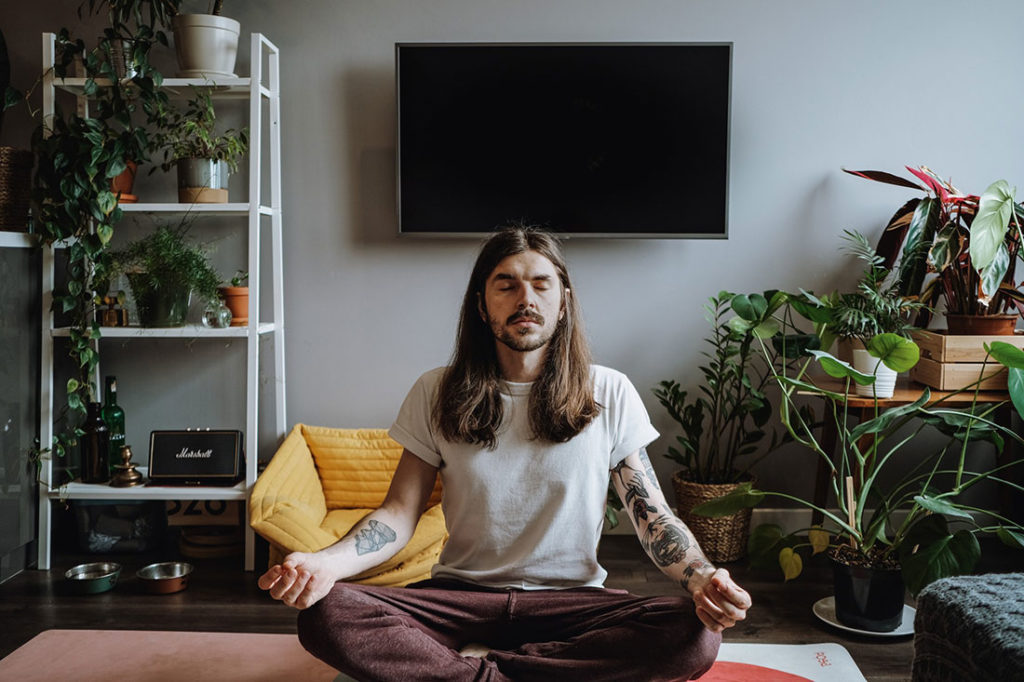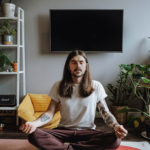The bell rang.
Noble silence ended. I stood in a circle of 33 people, and during the past four days, we had not spoken. We hadn’t even looked at each other in the eye.
We hadn’t used phones or computers, listened to music, read books, or written. We’d spent four days together at a silent meditation retreat, where all of those actions are forbidden. And now that it was over, now that I could do all of those things again, I cried.
At 41, I achieved a quiet mind for the first time since infancy. This calm was hard won. The first two days of the retreat were a combination of boredom, emotional exhaustion, and physical pain. Remove distractions and movement, and things get uncomfortable. Three days into the retreat, however, my mind and body settled. During the last 24 hours, my mind could rest in the present moment—not just for seconds at a time, my usual meditation experience—but it could linger there. I can’t overstate the peace this brings.
Hence my tears. Within an hour of that bell, I’d leave this retreat center in the North Carolina woods to return to my real life in Charlotte. Only my phone knew how many texts and emails awaited me. My peace had the shelf life of a ripe avocado.
Before the retreat, the challenge seemed to be surviving four days without talking, texting, or scrolling. A bigger challenge followed: how to bring zen home.
Total silence can’t be my new lifestyle, of course. I’m a writer. I interview people every day, and I spend almost as much time with my laptop as my husband. Focus and inner peace are lovely, but so are paid bills. Plus, I like people. Sometimes I even like my phone.
The retreat taught me, however, that my mind was capable of a calm it hadn’t known. Four decades of incessant stimuli had accumulated in that brain. I started the business of busyness early, as a fifth grader taking five ballet classes a week while maintaining top grades, who—even then!—found pride and validation in exhaustion. During the decades after, each stage became an investment in the next: enhancing that college application, getting that promotion, building that portfolio. Like many, I’ve spent most of my life investing in the future and analyzing the past at the cost of present peace.
In my late thirties, I discovered a contentment in meditation and mindfulness that felt countercultural. Time on the cushion taught me that right now is enough. Time at the retreat advanced this lesson, showing me it’s not enough to think with a new perspective, but to think about how I think. Meditation and mindfulness may look a lot like nothing from the outside, but for me, they’ve changed nearly everything from within.
Science supports this. Thanks to the study of neuroplasticity, we know that we can alter the physical structure of our brains. Just as a diet of food shapes how we feel, a diet of habits shapes how we think. Studies have shown that mindfulness and meditation practices increase gray matter in the hippocampus (increasing memory and focus) and decrease gray matter in the amygdala (decreasing stress and anxiety). I doubt that four days at a retreat were enough to alter my neural pathways, but I could vouch that several days of reduced stimuli brought greater clarity and focus. The idea that our brains physically respond to the stimuli we feed them is both empowering in its potential and overwhelming in its responsibility. I needed a new mental diet.
The retreat inspired me to create a new daily practice I call Strategic Nothingness. My goal was to bring the most powerful elements of the retreat home, to train myself to be where and when I am through a three-pronged approach of meditation, mindfulness, and, well, nothing. Instead of six and a half hours of meditation that I had each day at the retreat, Strategic Nothingness would steal brief moments throughout the day in the hopes of a cumulative effect.
I sought to answer the questions born of that retreat: Can I maintain the peace of a silent retreat amid the noise of regular life? Can I balance zen with productivity?
1. Daily Meditation
Even though I practiced meditation for five years before the retreat, I had grown inconsistent. When life ran smoothly, it’d fall off. When it got stressful, I’d pick it up again. I was using meditation like an Advil, when it needed to be a daily vitamin.
The brain, of course, is a muscle. Exercising this muscle, like any, requires regular repetition. Elizabeth Hoge, Ph.D., is a psychiatrist and associate professor at Georgetown University who studies the impact of mediation on the body. She gauges the impact of meditation by several measures, including levels of cortisol, the body’s stress hormone. Cortisol spikes during stress, as it always has for humans, but the body can’t distinguish between the stress of being chased by a bear and the stress of imagined thoughts, like, “Am I going to lose my job?” or “Will this project fail?” That’s how a meditation practice helps. Each day, it slowly trains our brains to recognize a thought for what it is: a temporary mental state and not a bear. Hoge has found that this training can lower cortisol levels.
“[With meditation,] you’re training your mind like a muscle to direct attention and to not get distracted by thoughts,” Hoge says. “It’s very much a skill that you must practice. When you notice a thought, you see it more clearly and you don’t get caught up in it.”
I began a no-excuses meditation practice of 15 minutes first thing, every day. I bought a bright aqua meditation cushion that shouts its presence in my very neutral-colored home, and each morning, it’s my rear on that cushion, no matter how busy my day or how late my night. I sit and teach myself to distinguish the thoughts from the bears. (To date, no bears.)
2. One Mindful Habit
Meditation and mindfulness aren’t the same thing. While meditation involves close awareness of thoughts, mindfulness is simpler, if not easier. It’s the act of being where we are, paying attention to what we’re doing, and engaging our senses.
During the retreat, the leaders told us to do everything mindfully. Our meals were mindful, as we’d eat slowly, setting the fork down between bites, noticing the food’s textures, temperatures, and flavors. We walked mindfully, feeling the ground under our feet, sensing the shift in balance from one leg to the next. As I explored the retreat center’s grounds, I could detect that the breeze on my face felt a bit different than the one that reached my arms (was it really swifter and cooler just a couple feet away?), and I heard tree branches creaking as they swayed above me. Take away my phone, add a little mindfulness, and I wandered the world like a woman on Ecstasy.
Within a week of coming home, I was back to my usual speed-walking pace and scarfing breakfast while hunched over a magazine. Constant mindfulness is not conducive to a productive life. I sought, however, to maintain one daily habit that I could convert into a mindful habit. I chose The Mindful Shower.
Showers are typically when I anticipate my day, think about upcoming meetings, mentally draft stories. Often my brain is so preoccupied that I forget whether I’ve shampooed and conditioned or merely shampooed, resulting in both stress and limp hair. I decided to convert my stressed-out showers to mindful showers.
A shower might be the easiest habit to trade for a mindful habit. It’s sensory overload in there: the hot water splashing my face, the scent of Aveda shampoo, the feeling of an exfoliant scrub on my legs. Whenever my mind begins drafting a story, I stop and focus on the temperatures, the scents, and the textures of a great shower. This felt hilariously hard at first, causing me to mentally narrate my showers. “I’m shampooing, I’m shampooing. I wonder how traffic will be on I-77.… Oops, I’m conditioning, I’m conditioning.” It was a slow retraining of the mind that became easier to apply to other habits, like workouts and cooking.
With The Mindful Shower, I transformed a formerly null part of my routine into a found moment of mindfulness. I feel cheated now. Showers have always been this relaxing, and I missed noticing because of… meetings or something?
3. Reclaim the Margins
The retreat had free time scheduled throughout the day, and without access to a phone, computer, or conversation, this became my nothing time. I’d sit on a bench and… just sit. I’d take a walk and simply look around. It lacked the awareness of mindfulness but never delved into boredom.
The Dutch call this pleasant idleness niksen. The Italians call it dolce far niente, the sweetness of doing nothing. We Americans, however, tend to forget that sometimes, nothing is the most productive thing we can do.
The tricky thing is that I don’t have much time to devote to nothing, as there are a lot of somethings on my schedule. I was far too busy to do nothing each day, right?
I began a quest to find something I could trade for nothing. The easiest something: waits. I’ve reclaimed life’s daily margin times as nothing times, in grocery check-out lines, at red lights, in the doctor’s office, or waiting for friends. I don’t catch up on texts, I don’t create to-do lists, I don’t check Instagram. I let my brain relax.
For the first week, this involved a funny little hand dance. My hand would instinctively reach for the phone in my purse, and I’d pull it back, and then 15 seconds later, my hand would reach again, and I’d pull it back, and surely I looked like I was having a spasm. By the second week, it became a new habit.
Realizing that trading phone time for nothing time meant trading up, I questioned my entire digital routine. One evening as I scrolled through Twitter, my dog sat beside me while she blankly chewed on a plastic bone. She didn’t seem particularly happy about that bone, yet she seemed unable to put it down. I laughed to realize the obvious analogy to my brain on Twitter, just chewin’ on a plastic bone.
Not only did I stop using my phone during waits, I minimized it altogether. I set 15-minute daily timers for the two social media apps I use. I feel more fulfillment—even dolce—in doing nothing.
The Effect of Strategic Nothingness
Six weeks into my practice of Strategic Nothingness, I’ve realized I don’t feel the intense peace that followed the retreat, I do feel more calm and less distracted. I’ve hoped for a sign to tell me how well it was working, but signs are hard to come by. It’s tough to quantify zen.
It’s possible to quantify income, however, a subject near and dear to this freelancer’s heart. During this time, I accepted about 75 percent more assignments than usual and invoiced nearly twice my goal. My hours barely increased. I wasn’t working more; I was working better and happier.
One weekend, my husband Jimmy and I went camping near Black Mountain, North Carolina.
Camping Me is the best me. I’m at my most peaceful, as ready to hike up a mountain as nap in a hammock. On Saturday morning, as I enjoyed an apple and the mountain view outside of our tent, I told Jimmy, “I don’t feel different here this time.”
He looked at me with concern, but found me smiling. It wasn’t that I felt any less peaceful here, it was that I had become more peaceful back home. During my most productive, lucrative month of the year, I maintained Camping Me status.
The question I asked in the Carolina woods was answered in the Carolina mountains: Can I balance zen with productivity?
It turns out I can, thanks to nothing.
This article originally appeared in the January/February 2020 issue of SUCCESS magazine. Featured image by @vadim_gringo/Twenty20







